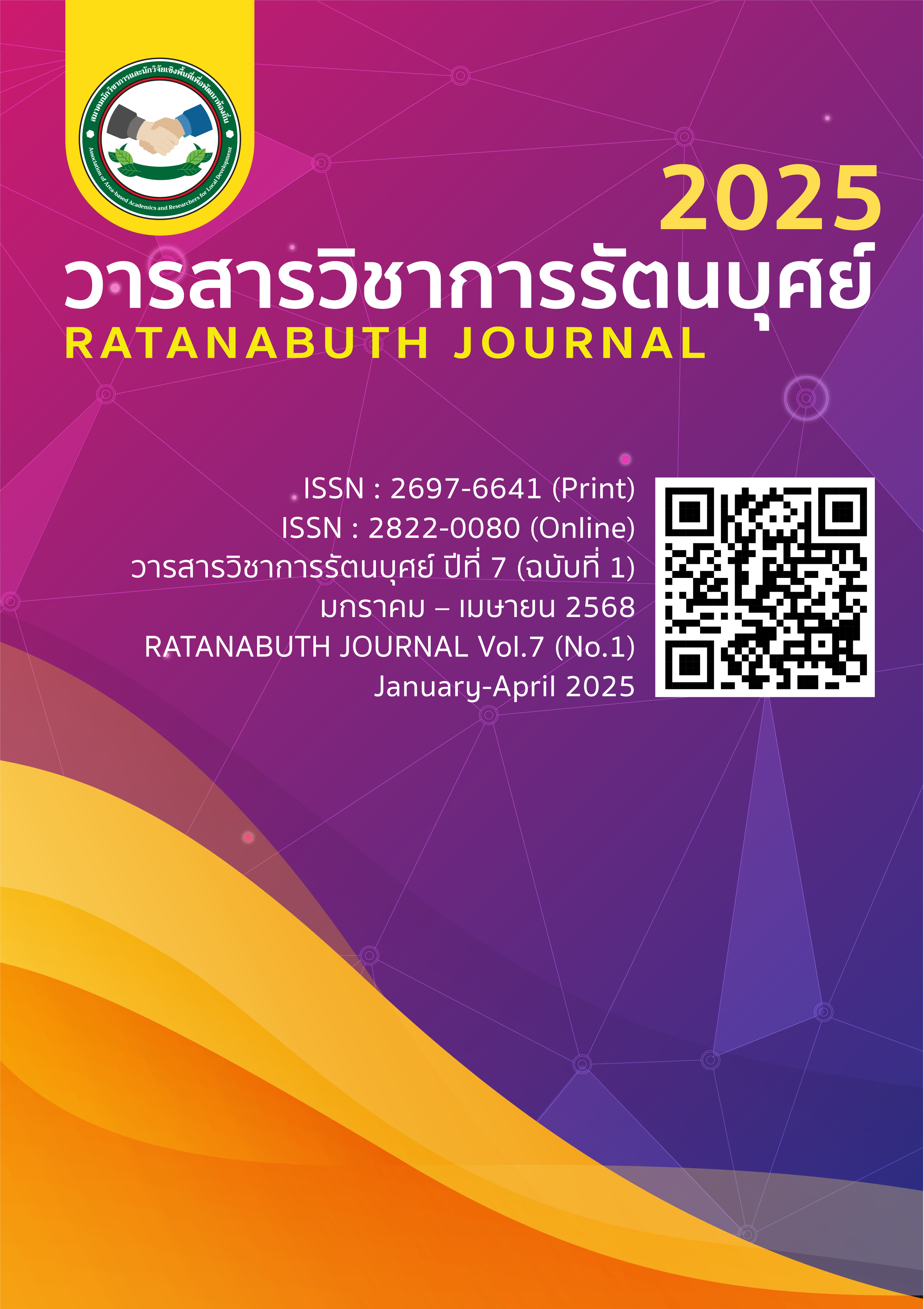Personnel Management According to the Four Brahmavihāra Principles in Educational Institutions Personnel Management According to the Four Brahmavihāra Principles in Educational Institutions
Main Article Content
Abstract
Concepts about personnel management It is a social process that relies on groups of people working together. To achieve the organization's goals the main aim is to make the work achieve the organization's objectives efficiently and always evolving and there are many theories about personnel management. In this article, Maslow's theory of the hierarchy of needs has been presented. There are 5 stages: 1) Physical needs, such as the four essential needs. sexual desire, etc. 2) Needs for safety and security, such as being protected taking care when sick and stable work 3) Social needs participation and acceptance by society 4) The need for respect from others. and the need for self-acceptance and esteem. 5) The need for maximum self-achievement It is the need to develop oneself according to one's highest potential. That is, when the final destination is reached, there will be further goals according to one's potential. As for personnel management according to the 4 Brahmavihāra principles in educational institutions, educational institution administrators can apply the 4 Brahmavihāra principles, namely kindness, compassion, mutita, and upekkha, namely: 1) Applying kindness in personnel management. 2) Adopting kindness in personnel management, 3) Adopting mudita in personnel management, and 4) Adopting equanimity in personnel management, such as conflict management. You should listen to all sides objectively. When there is a problem or conflict executives who use equanimity are able to carefully consider the facts. Don't be attached to personal feelings. and make fair decisions therefore, school administrators who are able to control their emotions and make fair decisions will gain the respect and confidence of personnel and can lead educational institutions to success.
Article Details

This work is licensed under a Creative Commons Attribution-NonCommercial-NoDerivatives 4.0 International License.
References
แก้ว ชิดตะขบ. (2547). รวมวิชาธรรมศึกษา ชั้นตรี (ตามหลักสูตรของสนามหลวงแผนกธรรม พ.ศ. 2546). กรุงเทพมหานคร: โรงพิมพ์การศาสนา.
ทิพาวดี เมฆสวรรค์. (2556). เอกสารการสอนชุดวิชาการบริหารงานบุคคลภาครัฐ. นนทบุรี: โรงพิมพ์มหาวิทยาลัยสุโขทัยธรรมาธิราช.
ธงชัย สันติวงษ์. (2542). การบริหารงานบุคคล (พิมพ์ครั้งที่ 10). กรุงเทพมหานคร: ไทยวัฒนาพานิช.
บุญมี แท่นแก้ว. (2539). จริยศาสตร์. กรุงเทพมหานคร: โอเดียนสโตร์.
ปัญญานันทภิกขุ (ปั่น ปญานนฺโท). (2541). หน้าที่ของคน (ฉบับสมบูรณ์). กรุงเทพมหานคร: ธรรมสภา.
พระเทพโสภณ (ประยูร ธมฺมจิตฺโต). (2539). มณีแห่งปัญญา. กรุงเทพมหานคร: ธรรมสภาและสถาบันบันลือธรรม.
พระธรรมกิตติวงศ์ (ทองดี สุรเตโช). (2541). พระในบ้าน. กรุงเทพมหานคร: คาธาวรรณการพิมพ์.
พระธรรมปิฎก (ป.อ. ปยุตฺโต). (2542). พุทธธรรม. กรุงเทพมหานคร: มหาวิทยาลัยมหาจุฬาลงกรณราชวิทยาลัย.
พระพรหมคุณาภรณ์ (ป.อ. ปยุตฺโต). (2551). พจนานุกรมพุทธศาสตร์ ฉบับประมวลธรรม (พิมพ์ครั้งที่ 16). กรุงเทพมหานคร: เอส.อาร์.พริ้นติ้ง แมส โปรดักส์ จำกัด.
พระสัทธัมมโชติกะ ธัมมาจริยปรมัตถโชติกะ. (2540). มหาอภิธัมมัตถสังคหกฎีกา (พิมพ์ครั้งที่ 5). กรุงเทพมหานคร: โรงพิมพ์มหาจุฬาลงกรณราชวิทยาลัย.
มหาจุฬาลงกรณราชวิทยาลัย. (2539). พระไตรปิฎกภาษาไทย ฉบับมหาจุฬาลงกรณราชวิทยาลัย. กรุงเทพมหานคร: โรงพิมพ์มหาจุฬาลงกรณราชวิทยาลัย.
มหาวิทยาลัยสุโขทัยธรรมาธิราช. (2536). แนวการศึกษาชุดวิชาการวิจัยการบริหารการศึกษาหน่วยที่ 1–7. นนทบุรี: มหาวิทยาลัยสุโขทัยธรรมาธิราช.
ราชบัณฑิตยสถาน. (2556). พจนานุกรมฉบับราชบัณฑิตยสถาน พ.ศ. 2544. กรุงเทพมหานคร: ราชบัณฑิตยสถาน.
ราชบัณฑิตยสถาน. (2548). พจนานุกรมศัพท์ศาสนาสากล อังกฤษ–ไทย ฉบับบัณฑิตยสถาน (พิมพ์ครั้งที่ 2). กรุงเทพมหานคร: ห้างหุ้นส่วนจำกัด อรุณการพิมพ์.
วิจิตร ศรีสอ้าน. (2532). เอกสารการสอนชุดวิชาหลักและระบบการบริหารการศึกษา เล่ม 1 หน่วยที่ 1–5. นนทบุรี: มหาวิทยาลัยสุโขทัยธรรมาธิราช.
วิชัย โถสุวรรณจินดา. (2551). การบริหารทรัพยากรมนุษย์ (พิมพ์ครั้งที่ 4). กรุงเทพมหานคร: โฟร์เพซ.
ศิริวรรณ เสรีรัตน์, สมชาย หิรัญกิตติ, และ สมศักดิ์ วาณิชยากรณ์. (2545). ทฤษฎีองค์การ. กรุงเทพมหานคร: ธรรมสาร จำกัด.
สุภาภรณ์ หาญณรงชัยกิจ. (2561). การศึกษาปัญหาและแนวทางการพัฒนาการบริหารงานบุคคลในสถานศึกษา สังกัดสำนักงานเขตพื้นที่การศึกษาประถมศึกษาชุมพร เขต 1.วิทยานิพนธ์ครุศาสตรมหาบัณฑิต. สุราษฎร์ธานี: มหาวิทยาลัยราชภัฏสุราษฎร์ธานี.
สมพงษ์ เกษมสิน. (2556). การบริหารงานบุคคลแผนใหม่ (พิมพ์ครั้งที่ 5). กรุงเทพมหานคร: ไทยวัฒนาพานิช.
สมาน รังสิโยกฤษฎ์. (2535). ความรู้ทั่วไปเกี่ยวกับการบริหารงานบุคคล (พิมพ์ครั้งที่ 17). กรุงเทพมหานคร: นำกังการพิมพ์.
สมเด็จพระญาณสังวร (เจริญ สุวัฑฒนมหาเถร) สมเด็จพระสังฆราช สกลมหาสังฆปริณายก. (2544). ทศบารมีทศพิธราชธรรม (พิมพ์ครั้งที่ 3). กรุงเทพมหานคร: มหามกุฏราชวิทยาลัย.
สมเด็จพระพุฒาจารย์ (อาจ อาสภมหาเถระ). (2548). หนังสือวิสุทธิมรรค (แปล) (พิมพ์ครั้งที่ 6). กรุงเทพมหานคร: บริษัท ธนาเพรส จำกัด.
สมเด็จพระมหาสมณเจ้า กรมพระยาวชิรญาณวโรรส. (2529). สารานุกรมพระพุทธศาสนา. กรุงเทพมหานคร: โรงพิมพ์มหามกุฏราชวิทยาลัย.
อุทัย หิรัญโต. (2547). หลักการบริหารงานบุคคล. กรุงเทพมหานคร: ไทยวัฒนาพานิช.
อำนวย แสงสว่าง. (2544). การจัดการทรัพยากรมนุษย์. กรุงเทพมหานคร: อักษรพิพัฒน์การพิมพ์.
อำภา บุญช่วย. (2549). เอกสารคำสอน 260-617 พฤติกรรมองค์การ. ปัตตานี: มหาวิทยาลัยสงขลานครินทร์ วิทยาเขตปัตตานี.
Owens, R. G. (2001). Organization behavior in education (7th ed.). Boston: Allyn & Bacon.


